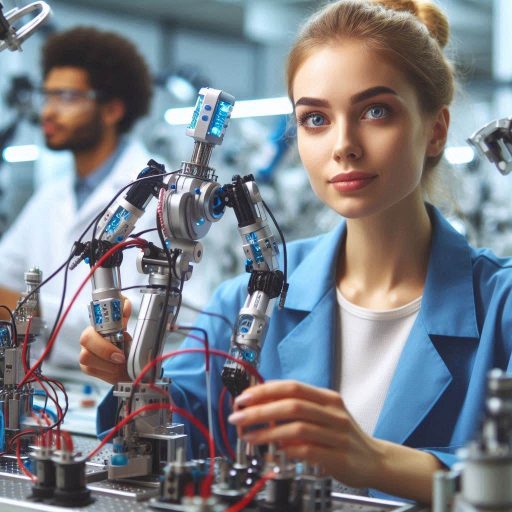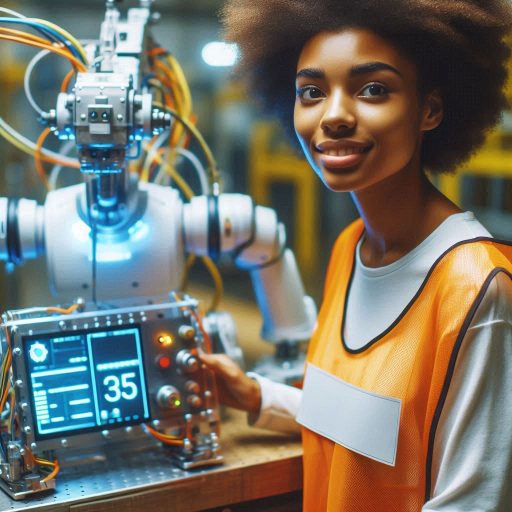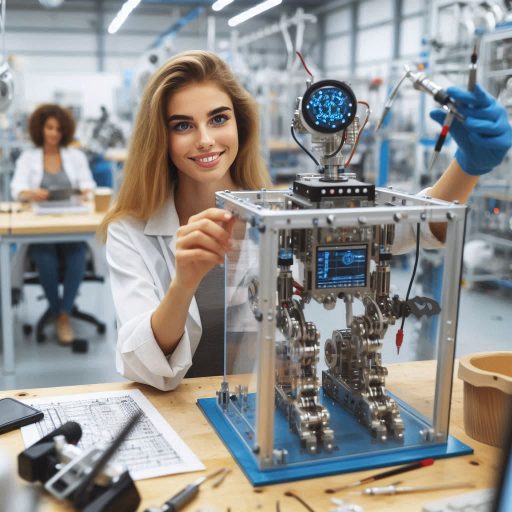Introduction
Robotics engineering is a multidisciplinary field that focuses on designing, building, and operating robots and automated systems.
It integrates principles from mechanical engineering, electrical engineering, and computer science to create machines capable of performing tasks autonomously or with minimal human intervention.
Robotics engineering is crucial in modern society due to its transformative impact across various industries.
It enhances efficiency, precision, and safety, driving advancements in manufacturing, healthcare, and everyday technology.
The process of developing a robot from concept to prototype involves several detailed stages.
First, engineers start by identifying a problem or a need that can be addressed with robotic technology.
This initial phase involves brainstorming and conceptualizing innovative solutions that the robot could provide.
Engineers then create detailed designs using computer-aided design (CAD) tools, which help visualize and plan the robot’s components and functions.
Once the design is finalized, engineers move on to building a prototype.
This prototype is a working model of the robot, constructed to test the feasibility of the design and evaluate its performance.
Engineers rigorously test the prototype to identify any issues or areas for improvement.
Based on these tests, they refine the design, making adjustments to enhance functionality, reliability, and efficiency.
Conceptualization stage
In the field of robotics engineering, the journey from concept to prototype begins with the conceptualization stage.
This phase sets the foundation for the entire project and involves several key steps:
Research and brainstorming
During this initial phase, the robotics engineers immerse themselves in extensive research to gather information and insights related to the project.
This may involve studying existing robotics technologies, analyzing market trends, and exploring relevant scientific literature.
Brainstorming sessions are also conducted to generate innovative ideas and solutions.
Identifying the problem that the robot will solve
One of the crucial tasks during the conceptualization stage is to clearly define the problem or challenge that the robot will address.
This could be anything from automating a repetitive task in a manufacturing plant to assisting individuals with disabilities in their daily lives.
By identifying the problem upfront, engineers can tailor their design and development efforts towards creating a solution that meets specific needs.
Defining the goals and objectives of the project
Setting clear goals and objectives is essential for guiding the design and development process towards a successful outcome.
These goals could include factors like the desired functionality of the robot, the target market or users, and the expected performance metrics.
By defining these parameters early on, the engineering team can stay focused and aligned throughout the project.
Overall, the conceptualization stage of robotics engineering plays a critical role in shaping the direction and scope of the project.
It lays the groundwork for the design and development phases, ensuring that the resulting prototype effectively addresses the identified problem and meets the project goals.
Read: The Future of Environmental Engineering Jobs
Design and Planning
Creating a Design Brief
The first step in robotics engineering involves creating a comprehensive design brief.
This document outlines the problem the robot will solve and specifies its intended functions.
Engineers need to identify key requirements, such as performance goals, size constraints, and environmental conditions.
The design brief should include details about the robot‘s intended tasks, such as assembling parts or navigating obstacles.
It also defines the criteria for success, including reliability, accuracy, and safety.
A well-crafted design brief serves as a roadmap for the entire development process, guiding engineers through each stage of design and construction.
Choosing the Right Materials and Components
Selecting the appropriate materials and components is crucial for building a successful robot.
Engineers evaluate materials based on strength, weight, durability, and cost.
For structural components, lightweight but strong materials like aluminum or carbon fiber are often preferred.
Components such as motors, sensors, and controllers must meet the specific performance requirements outlined in the design brief.
Engineers choose motors based on their power and precision, while sensors are selected for their accuracy and responsiveness.
The choice of materials and components impacts the robot‘s overall functionality, efficiency, and cost.
Making informed decisions during this phase ensures the robot will perform as intended and withstand operational stresses.
Developing a Detailed Plan for Construction
A detailed construction plan is essential for translating the design into a working prototype.
Engineers start by creating detailed schematics and assembly instructions based on the design brief.
This plan includes step-by-step procedures for assembling components, integrating systems, and conducting tests.
Engineers outline the sequence of assembly, ensuring that each part fits and functions correctly.
The construction plan also includes timelines and milestones, which help track progress and identify potential issues early.
Effective planning helps streamline the assembly process, reduces errors, and ensures that the prototype meets all design specifications.
By following a well-structured plan, engineers can efficiently build a robot that functions as intended and is ready for further testing and refinement.
Basically, the journey from concept to prototype in robotics engineering involves creating a thorough design brief.
selecting the right materials and components, and developing a detailed construction plan.
Each step is crucial for ensuring that the final robot meets its intended functions and performance criteria.
By carefully planning and executing these stages, engineers can successfully turn innovative ideas into practical, high-performing robotic systems.
Read: Environmental Engineering Software and Tools
Development of the prototype
Developing a prototype in robotics engineering involves a series of crucial steps that require precision and expertise.
This phase is where the theoretical concepts are transformed into a tangible and functional robot that can perform specific tasks.
Let’s delve into the detailed process of building a prototype in robotics engineering.
Building the physical structure of the robot
The first step in developing a prototype is designing and building the physical structure of the robot.
This involves creating a robust and durable frame that can support all the necessary components and withstand the rigors of its intended tasks.
Engineers typically use CAD software to design the robot’s structure, taking into account factors such as weight distribution, balance, and maneuverability.
Once the design is finalized, the next step is to manufacture the parts using various techniques such as 3D printing, CNC machining, or traditional fabrication methods.
The physical structure serves as the foundation upon which all other components will be integrated, making it a critical aspect of the prototyping process.
Integrating sensors, actuators, and other electronic components
After the physical structure is completed, the next step is to integrate sensors, actuators, and other electronic components that are essential for the robot’s functionality.
Sensors play a crucial role in gathering data from the robot’s environment, allowing it to perceive and interact with its surroundings effectively.
Actuators, on the other hand, are responsible for translating the robot’s commands into physical actions.
Integrating these components requires careful planning and precise execution to ensure seamless communication and functionality.
Engineers must consider factors such as power consumption, compatibility, and signal processing capabilities when selecting and integrating sensors and actuators into the robot’s design.
This phase often involves soldering, wiring, and testing each component to ensure proper functioning and connectivity.
Writing the code for the robot’s functionality
Once the physical structure and electronic components are in place, the final step in developing a robot prototype is writing the code that governs its functionality.
This involves programming the robot to perform specific tasks, respond to stimuli, and interact with its environment autonomously or through user commands.
Engineers typically use programming languages such as C++, Python, or Java to write the code for the robot.
They must consider factors such as efficiency, complexity, and real-time responsiveness when designing the algorithm that controls the robot’s behavior.
Debugging and testing the code are essential steps to identify and address any errors or malfunctions that may arise during operation.
In essence, the development of a robot prototype is a complex and multifaceted process that requires meticulous planning, design, and execution.
By following these steps and leveraging the latest technologies and methodologies in robotics engineering, engineers can create innovative and functional robots that push the boundaries of automation and intelligence.
Read: Environmental Engineering and Marine Conservation
Transform Your Career Today
Unlock a personalized career strategy that drives real results. Get tailored advice and a roadmap designed just for you.
Start NowTesting and Iteration
Conducting Initial Tests to Identify Issues
Once the initial prototype of a robot is built, conducting initial tests is crucial.
These tests help identify any design or functional issues early in the process.
Engineers perform a series of assessments to evaluate the robot‘s performance under various conditions.
This includes testing movement accuracy, sensor functionality, and overall system integration.
The goal is to uncover any problems that could affect the robot’s efficiency or reliability.
During these initial tests, engineers look for discrepancies between the prototype’s performance and its intended specifications.
They examine the robot‘s ability to complete tasks, detect errors, and assess how well it interacts with its environment.
Any issues identified during these tests are documented and analyzed to understand their root causes.
This stage is essential for pinpointing weaknesses in the design or functionality of the robot.
Making Necessary Adjustments and Improvements
Based on the results of the initial tests, engineers make necessary adjustments and improvements to the prototype.
This phase involves revising the design, updating software, or replacing faulty components.
Adjustments are made to address the specific issues identified during testing.
For instance, if the robot‘s sensors are not providing accurate data, engineers might recalibrate them or replace them with more precise ones.
Engineers also focus on optimizing the robot‘s performance by refining its algorithms and enhancing its mechanical components.
They make iterative changes to improve the robot‘s efficiency, reliability, and overall functionality.
Each adjustment aims to bring the prototype closer to meeting the desired specifications and performance standards.
Repeating the Testing Process Until the Prototype Meets the Desired Specifications
After making adjustments, the testing process is repeated to ensure that the changes have resolved the identified issues.
Engineers conduct additional tests to verify that the improvements effectively address previous problems.
This iterative testing process helps validate the modifications and confirms that the prototype now meets the desired specifications.
Repeating tests allows engineers to fine-tune the robot further, ensuring it performs reliably under various conditions.
Each cycle of testing and adjustment brings the prototype closer to its final form.
This process continues until the robot consistently meets all performance criteria and operates as intended.
The iterative nature of testing and refining is crucial for developing a successful robotic system.
It ensures that the prototype is not only functional but also optimized for its intended applications.
The goal is to create a robot that performs effectively, meets quality standards, and is ready for production or further development.
In review, the process of conducting initial tests, making adjustments, and repeating testing is fundamental in robotics engineering.
These steps ensure that prototypes are refined and perfected to meet desired specifications.
Through rigorous testing and continuous improvement, engineers develop robots that are reliable, efficient, and capable of performing their intended tasks effectively.
Read: Environmental Engineering and Corporate Social Responsibility

Explore Further: Emerging Technologies in Petroleum Engineering
Integration of advanced features
Incorporating AI and Machine Learning Algorithms
Incorporating AI and machine learning algorithms into robotics is transforming how robots operate.
AI enables robots to process data, make decisions, and adapt to various situations.
Machine learning algorithms help robots improve their performance over time by learning from experience.
Engineers integrate these technologies to enhance the robot’s ability to perform complex tasks autonomously.
AI algorithms analyze data from sensors and cameras to interpret the robot‘s environment.
This analysis allows the robot to recognize patterns, identify objects, and make informed decisions.
For instance, a robot equipped with computer vision can use AI to distinguish between different types of objects and navigate around obstacles.
Machine learning algorithms refine the robot’s abilities by learning from previous interactions and performance.
As the robot encounters different scenarios, it collects data that the machine learning model uses to improve its responses.
This iterative learning process helps the robot adapt to new environments and tasks more effectively.
Implementing Autonomous Capabilities
Implementing autonomous capabilities is crucial for advancing robotic technology.
Autonomous robots can operate without constant human intervention, performing tasks independently and efficiently.
To achieve autonomy, engineers equip robots with sophisticated sensors, control systems, and decision-making algorithms.
Autonomous robots rely on real-time data from various sensors to understand their surroundings.
They use this data to navigate, avoid obstacles, and perform designated tasks.
For example, a delivery robot uses GPS, cameras, and lidar sensors to navigate through streets and deliver packages to specific locations.
Engineers develop and integrate control systems that allow robots to make decisions based on sensor data and predefined rules.
These systems enable the robot to adjust its actions in response to changing conditions, ensuring it can handle dynamic environments.
Autonomous capabilities improve the robot’s versatility and operational efficiency.
Enhancing the Robot‘s Performance and Efficiency
Enhancing the robot‘s performance and efficiency involves optimizing both hardware and software components.
Engineers focus on improving the robot’s mechanical design, sensor accuracy, and algorithm efficiency.
Performance enhancements lead to faster, more reliable, and energy-efficient robots.
Optimizing hardware includes refining mechanical parts for better durability and precision.
Engineers also enhance sensors to provide more accurate data, which improves the robot‘s ability to perform tasks effectively.
Software optimizations, such as refining AI algorithms and machine learning models, boost the robot‘s decision-making and adaptability.
Efficiency improvements involve reducing the robot‘s energy consumption and increasing its operational lifespan.
Engineers develop energy-efficient components and optimize software to minimize power usage.
By enhancing the robot’s performance and efficiency, engineers ensure that it operates effectively and meets the demands of its intended applications.
In summary, incorporating AI and machine learning algorithms into robotics is key to developing advanced autonomous systems.
Implementing these technologies enhances the robot’s ability to perform tasks independently and efficiently.
By focusing on both hardware and software improvements, engineers optimize the robot‘s performance and ensure it operates reliably in various environments.
Finalizing the prototype
Fine-Tuning the Design and Functionality
After initial design and development, fine-tuning is crucial.
Engineers start by refining the prototype‘s mechanical and electronic systems.
They adjust the robot‘s design based on performance data and feedback.
This involves optimizing components such as sensors, actuators, and controllers to improve functionality and efficiency.
Engineers also enhance the software to ensure that the robot performs tasks accurately.
Iterative adjustments are made to balance performance with cost and manufacturability.
Fine-tuning often requires revisiting design specifications and making iterative changes to achieve the desired outcome.
Conducting Thorough Testing to Ensure Reliability
Testing is a vital phase in developing a reliable robotic system.
Engineers conduct various tests to evaluate the robot‘s performance under different conditions.
These tests include functional testing, stress testing, and environmental testing.
Functional testing verifies that the robot performs all intended tasks correctly.
Stress testing assesses the robot‘s durability and resilience under extreme conditions.
Environmental testing examines how the robot operates in different environments, such as varying temperatures or humidity levels.
Comprehensive testing helps identify and rectify potential issues before full-scale production.
It ensures that the prototype meets reliability and safety standards.
Documenting the Entire Development Process for Future Reference
Documenting the development process is essential for future reference and continuous improvement.
Engineers create detailed records of each design iteration, testing phase, and modification made.
This documentation includes design schematics, code, test results, and feedback notes.
Maintaining thorough records allows teams to track progress and understand the rationale behind design choices.
It also facilitates troubleshooting and debugging by providing a reference for past issues and solutions.
Proper documentation supports knowledge sharing and can be invaluable for future projects or upgrades.
It ensures that the development process is transparent and can be reviewed or replicated as needed.
Ultimately, fine-tuning the design and functionality, conducting thorough testing, and documenting the development process are crucial steps in transforming a robotics concept into a working prototype.
Each phase ensures that the final product meets performance, reliability, and quality standards.
By carefully executing these steps, engineers can develop innovative robotic systems that fulfill their intended purposes and pave the way for future advancements in robotics technology.
Uncover the Details: Pros and Cons of Being a Field Service Technician
Delve into the Subject: Transitioning to Data Science from Another Field
Explore Further: Advancements in Marine Engineering Technology
Conclusion
The robotics engineering process encompasses several crucial stages: conceptualization, design, development, and prototyping.
Each stage builds upon the previous one to bring a robot from an initial idea to a functional prototype.
During conceptualization, engineers identify the problem, define objectives, and brainstorm potential solutions.
The design phase involves creating detailed plans and specifications, including mechanical, electrical, and software components.
Development follows, where engineers build and assemble the robot according to the design.
Finally, prototyping involves testing and refining the robot to ensure it meets the intended goals.
Innovation and creativity are essential throughout this process.
Engineers must continuously explore new ideas, materials, and technologies to enhance robot performance and capabilities.
Creativity fuels the development of novel solutions and unique approaches, enabling robots to tackle complex tasks and adapt to diverse environments.
Looking ahead, robotics engineering holds immense promise for future advancements.
Emerging technologies such as artificial intelligence (AI) and advanced materials will further expand robotic capabilities.
AI integration will enable robots to learn from their environment, make autonomous decisions, and perform tasks with greater precision.
Advanced materials will enhance robot durability, flexibility, and efficiency.




